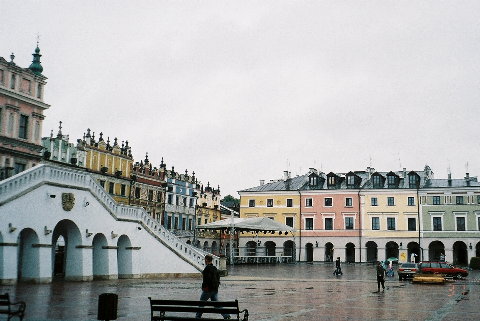
Our first stop along the way was in Zamosc. This is a UNESCO World Heritage site, with its Renaissance market square, designed in the Italian style. I'd have liked to meander slowly around and read the signs describing each house, but Mom was complaining about the weather, so settled for a visit to a coffee house.

Most of the rest of the day was spent driving, with a brief stop for lunch. We arrived in Krakow in the early evening, bade farewell to Tomasz, and settled into the Hotel Copernicus. The hotel was just oozing with character and was nicely centrally located. On the way to get dinner, Mom bought a fleece jacket. She still complained - it was too short, not the right color, the sales clerks spoke Polish - but none of that stopped her from wearing it during the rest of the trip. I will also note that she objected to my taking her picture, but she insisted I include it here.
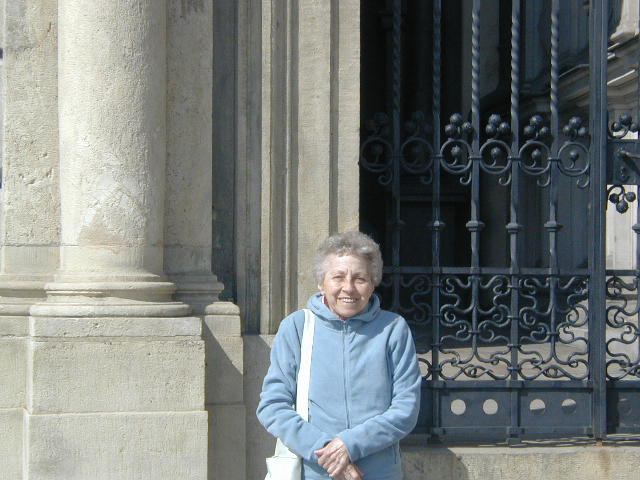
As for dinner, Krakow has an amazing diversity of restaurants and I took the opportunity to introduce Mom to one of my favorite cuisines at a Georgian restaurant. "What's Georgian food like?" she asked. "Lots of garlic," I assured her and she did, indeed, enjoy it.
In the morning, we met our local guide, Monika and our driver. The first part of our touring was Jewish Krakow and began with a visit to the Kazimierz district. This was originally a separate city and only later merged into Krakow itself. We walked through a courtyard that Steven Spielburg had used as the ghetto in Schindler's List, but the actual ghetto was in Podgorze, not Kazimierz. We continued through a market square and on to Isaac's Synagogue. This is partly restored and shows a silent film about the ghetto and deportations.
The Remuh Synagogue, built for Rabbi Moshe Isserles (known as the Remuh) in 1557, is still in use and is attractive, though small.
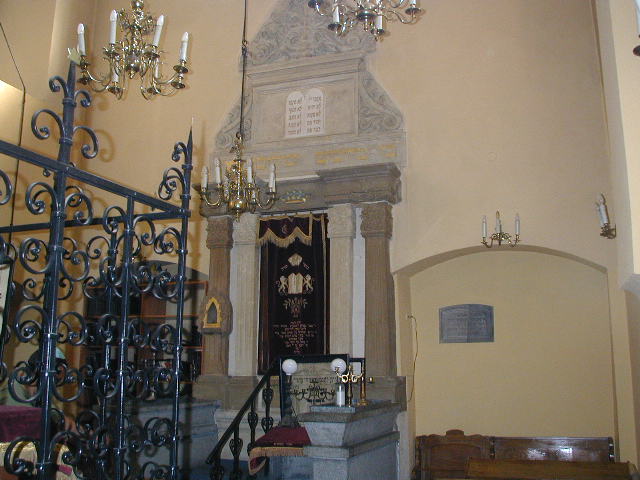
There's an adjoining cemetery, which includes the grave of the Remuh. The grave was not destroyed by the Nazis, possibly out of superstition. Many of the other tombstones are restored and there is a wall made from fragments of ones which were destroyed.
By the way, this area (on Szeraka Street) has a sort of revival of Jewish culture, but there are only about 120 Jews in Krakow. Most of the shops selling Judaica and restaurants offering Jewish-style food and klezmer music are run by non-Jews. In addition to the two synagogues we visited, there's a third, which hosts a museum. Monika said it was more or a primer, assuming people know nothing about Jewish life, so we didn't bother to visit it.
We did, however, visit the Galician Museum. This is the work of a British photographer named Chris Schwartz and consists largely of photographs of destroyed Jewish life. There are photos of remains of sites from before the war, of the extermination camps, and sites after the war. The most interesting part of the museum was a special exhibit on the "Righteous Among Nations," i.e. Poles who were recognized for helping rescue Jews. Their personal stories often talked about the mixed reactions other Poles had about their actions.
We continued on to Podgorze, where the square marking the ghetto has a memorial consisting of empty chairs. Then we visited Schindler's factory, which has a restoration of his office and an exhibit with pictures both from Spielburg's film and from real life. We continued past a remaining bit of the ghetto wall and to a monument to the nearby concentration camp.
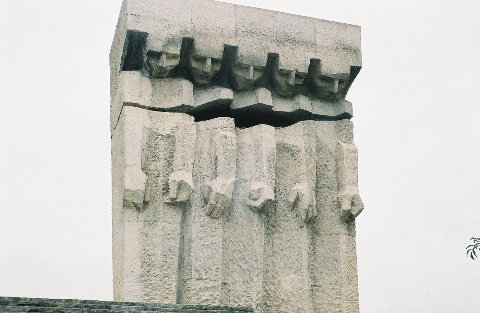
We drove back to the main part of Krakow and had lunch at a restaurant in the old city. Then we walked over to the University, which is one of the oldest in Europe. In the courtyard of the Collegium Maius, there's a mechanical clock which plays "Gaudeamus Igitur" at the hour. We continued on to the main market square (Rynek Glowny), which dates back ot the 13th century.
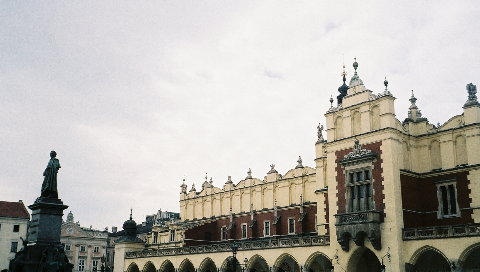
Monika pointed out the City Hall and the Cloth Hall, which is now primarily a souvenir market. We strolled around to St. Mary's Church. This has two towers and the story is that the older brother built the taller tower and his jealous younger brother stabbed him in revenge for that before jumping to his death from his own (lower) tower. Another story is that one tower represents the City and the other, the Church. The taller (city) tower is where a trumpet call, the Hejnal is sounded hourly to commemorate a medieval trumpeter who sounded an alarm before being killed by an arrow.

After visiting the interior of the church, which is known largely for its elaborate carved altar, we walked back along Ulica Grodyka. Krakow has no shortage of churches and one of the most impressive is the Church of Saint Peter and Paul. This is a copy of Il Jesu in Rome.
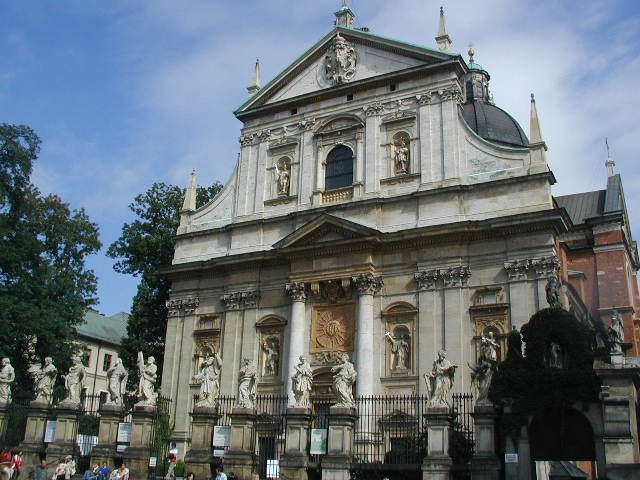
We continued on to Wawel Hill. "Wawel" means "safe place" and the hill has both the Royal Castle and the Wawel Cathedral.
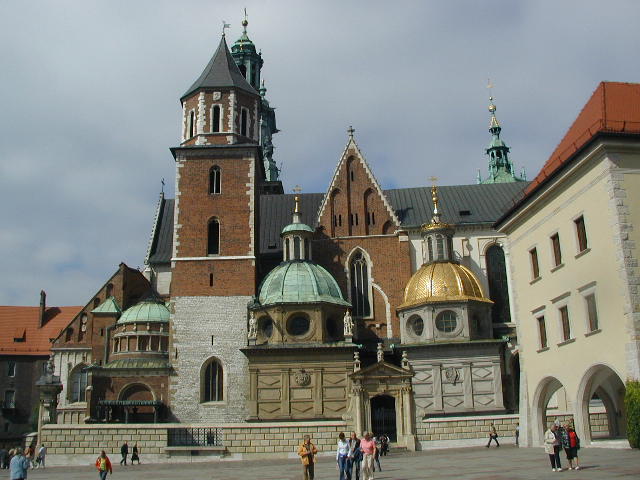
Our visit to the castle included three rooms on the ground floor and the royal apartments on the second floor. There is a series of tapestries depicting the story of Noah. The most impressive room is the Audience Hall. Its ceiling is decorated with carved heads wearing a wide variety of hats. One woman is shown with her mouth covered, allegedly because she dared to confront the king on his judgement about somebody's guilt.
The Cathedral has the largest bell in Poland, but it is rung just a few times a year. The main thing to see is royal tombs, many of them elaborately decorated. There is also a legendary dragon associated with the Cathedral. The story is that the dragon went around eating women until it was tricked into eating a sheep filled with sulfur, which made it explode. Fossil bones hung over the Cathedral door are said to be those of the dragon, though they look suspiciously like what the Smithsonian would identify as mammoth bones.
That was it for our city tour and I guess it wasn't quite enough because Mom had some energy left for shopping. She found a few odds and ends, which kept her content. I managed to make my usual obligatory souvenir purchase, in the form of a couple of books of folktales. One of them was specifically of Polish Jewish legends and even had a Chelm story I didn't already know.
Our other sightseeing in the area was a visit to Auschwitz. Our guide there, Zofia, spoke only Polish, but we were accompanied from Krakow by a translator, Javier. One enters through the famous gate, bearing the cynical inscription "Arbeit Macht Frei" or "Work Makes (You) Free."
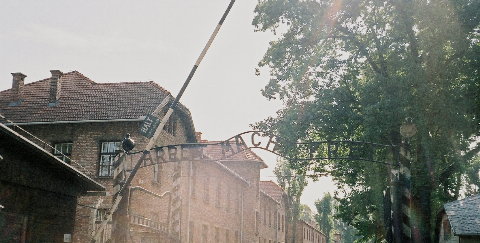
The tour includes several barracks and the conditions were obviously horrible. Men survived an average of six months, while women lived just three. Several of the barracks now exhibit what are called "material evidence of crimes," meaning stacks of belongings taken from the prisoners. Those include suitcases, shoes, clothing and, most chillingly, human hair. The other exhibits include models of gas chambers and crematoria, the "death wall" where prisoners were shot, and the house of Rudolph Hess.
We continued on to Auschwitz II - Birkenau, which was more directly an extermination camp. The barracks are much worse, particularly the washrooms / latrines, which people could use just a few minutes a day. The most impressive thing is the scale, which is obvious when you climb to the top of the watchtower. The engines of death are distressingly large.
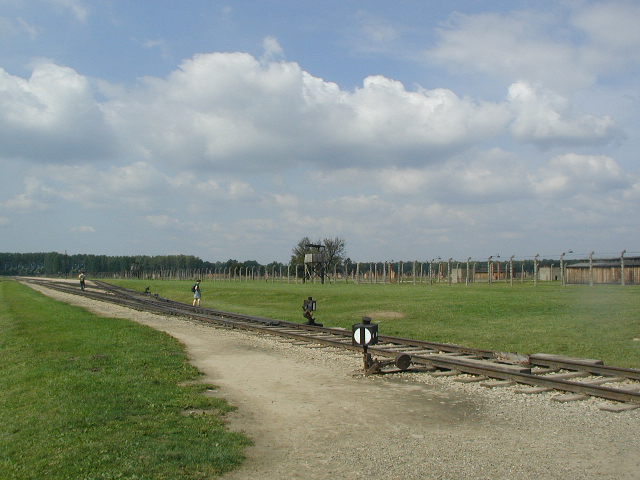
In some ways, however, the scale makes the experience less personal. I found the deserted sites and ruined cemeteries elsewhere in Poland to be sadder. And the real tragedy is that the absence of vital Jewish culture in Poland today suggests that the Nazis succeeded more than they realized.
We had more time that afternoon and evening and the next morning to meander around Krakow. Mom alternated attempts at shopping with napping, while I utilized some of her nap time to enjoy the local architecture. Mom worried about our train trip back to Warsaw, but all went smoothly, both with the train itself and the transfers to and from the stations at each end. The next morning we were off to the airport and our flight back to New York. About the only thing worth mentioning with respect to the flight is that this time Lot handed out digital video players in business class, allowing a reasonable choice of movies. On arrival, we had a long wait for our luggage, which made Mom nervous. She also complained about the long line to get a taxi at JFK, which may be annoying, but it's not like I could do anything about it.
Overall, this wasn't one of my more exciting vacations. I'd heard good things about Krakow for years and it is, indeed, an attractive example of a central European city, but not different enough to be worth going out of the way for. The most interesting part was seeing the villages in the northeast that my mother's side of the family was from. Finally, traveling with my mother confirmed my belief in what my brother, Elliot, calls the "Nadel exclusion zone." Namely, our family gets along far better if we're separated by at least a couple of hundred miles. I decided that if Mom ever wants to go somewhere again, Elliot is just going to have to get a passport!
[Back to Last Chapter | Back to Index]
Copyright 2006 Miriam H. Nadel
last updated 5 November 2006